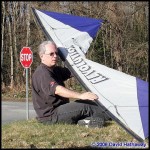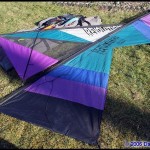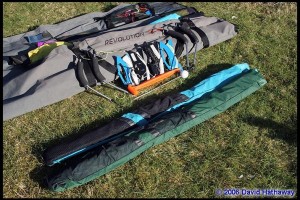So, you’ve decided that your flying has reached a point where you’d now like to go out and try on some competition. This can be a good thing (one I certainly now enjoy after years of avoiding competition like some manner of terrible plague), and it can go a little smoother if you are well prepared for what may come your way. This article takes a look at what you’ll ideally want to carry along with you as far as equipment goes. There’s really three approaches to “how much is enough”, but, one thing you really need to bear in mind that the famous guy Murphy, he of “Murphy’s Law” is very well employed at kite festivals. While you may have flown for years recreationally and never broke a single rod or line, competition will quickly give you a lesson in what can go wrong and how it will happen at precisely the wrong time. Bet on it.
So, scare tactics aside, where does one start accumulating a “reasonable” collection of gear that will cover you in most situations? There are three separate levels you can strive for with this. The first level is easy, simply show up with one kite, some line and a ground stake and go for it. The third level is really limited solely by your own budget, and it’s also pretty easy. Just buy three of everything possible, including a few good size bags to haul your complete kite store. That being said, I did see one reasonable size trailer at Lincoln City this summer that pretty much WAS an entire kite shop on wheels. But, what I’m aiming for with this article is the middle ground, a collection of the basics that will get you through most situations with relative ease.
Let’s start with one of the biggest variables at any kite competition, the one thing you can’t buy, influence or fix, the wind itself. As you start traveling to other festivals to collect your trophies, you’ll find a huge variety of wind, often within the space of afternoon, or, even in the time it takes to run through a group of flyers in a specific competition discipline. Trust me, there are few worse feelings that having the wind picks up and you are sitting there with an SUL sail.
So, first on the list, get a vented kite. Ideally, it will match the size of whatever you usually fly, i.e., a vented 1.5 to accompany your regular EXP or SLE, or, a vented 1 if that’s more what you prefer (though be warned, vented 1s can be tough to find lately, I think they are under the custom order category lately.).
Now, you are reasonably covered for the entire wind range of Revolutions. But, it doesn’t stop there. While you are at it, its worthwhile picking up a complete 2 wrap frame, which will give you even better low wind performance. If you were extra smart when you picked up your first rev and chose an SUL frame for it, you are now sitting on three complete frames, a 2, 3 and 4 wrap set (possible with an SLE if that’s your preference). This is going to leave you well equipped for nearly any wind condition and also gives you a few possible combination setups as well. For example, my current favorite framing is to have 2 wrap verticals (no matter what the wind, they rarely, if ever break) and a 4 wrap (non SLE) leading edge, unless I’m forced to a vented kite, in which case I’ll usually switch to an SLE leading edge.
My personal two favorites lately, an SLE Vented Rev 1 with the new sail pattern (note! The rods are in correctly on the back, that’s a reinforcement strip running down the sail) and a Sedgewick series Rev 1 that’s been lightened as much as possible and usually has a 4 wrap leading edge with 2 wrap verticals.
While we’re on the topic of leading edges that ranks as one of the most commonly broken rods in quads thus, in our effort to be prepared for anything, carry at least one complete spare, especially the middle piece. While you don’t necessarily have to have a complete leading edge for every frame type you have, you won’t go wrong with having at least one. I tend to make sure I have a spare 4 wrap as I can probably use this in most winds if I’m in a pinch.
One rather neat trick John Barresi showed me last summer, and is tailored to those of us who still prefer the non SLE rods for leading edges, take 2 complete 3 wrap leading edges and stuff them into one kite. For borderline high wind days, you’ll find this to be stiffer than a single 4 wrap leading edge, but, still a bit more flexible than a SLE. No, really, try it, I did it this past weekend and it was a great feeling kite when it wasn’t quite consistently windy enough for a vented kite, but, more than you’d feel comfortable flying with a standard kite. And if you really want a different feel, load up your vented kite with 2 wrap rods on a not so windy day. The key here is flexibility and an ability to adapt to the conditions no matter what Mother Nature decides to hurl your way.
One last tip on the above, when you are going into the pits to get ready for your time slot, take spares in with you. If the wind tends to be high, take your vented in as well as your regular kite. If its a non windy day, take in your regular and your 2 wrap frame set with you. You do get some time to switch in your warmup, but, I can guarantee you it will not be enough time to run back to wherever your bag is to root around and try and find all the pieces. Be prepared.
Now that we have covered off the most money consuming part of gathering your competition kite (and for those keeping count at home, we’re at 2 sails, one of which is vented, and three frames, 2, 3 and 4 wrap plus at least one full leading edge) we’ll look at line sets.
First off, consider Precision events. The grid marked off for precision is 200 feet wide, and 100 feet high, marked off in increments of 10 feet. I’m sorry, but, your treasured 60 foot line set is going to have a very tough time filling that grid and placing your elements at the correct approximate heights, so, at the very least, use 100 foot (at least) line sets for Precision events. This may not be your best choice for ballet, however, its going to be easier to fill the grid properly so as to thusly impress the judges with your precision grace. Again, this is an area where winds may cause you trouble, so, have at least two sets, a light 50 pound set for the light days, and at least a 90 pound set for general, high wind use. You may even want to have a 150 pound set “just in case” but, I’ve found 90 pounds to be adequate for any winds I have run into so far, but, I do have a junk set of 150s handy just in case. If you fly 100 feet for ballet as well, you are now reasonably covered off on line, but, remember our friend Murphy, have a third set as a spare, whichever weight you tend to use the most of. If you fly shorter lines in Ballet (as I tend to do, I usually will move to 75-80ish sets ) you’ll want to have spares for these lines as well though in a tight corner you can simply move back to a 100 foot set. Two further points to add to this, first, make sure to keep your winders are clearly labeled with the length and the weight of the line and secondly, check your line lengths on a regular basis for wear. I try to remember to swap the tops vs the bottoms on a frequent interval, this will help keep the wear and stretch even.
This leaves only the little things to worry about now. Always carry two sets of handles and as much as you can, make sure they are matched to each other. While it may seem fun to accumulate lots of different types of handles, make sure you have at least 2 sets that match identically.
Keep in mind that the stainless steel handles and graphite handles are different lengths, so, stick to one or the other for the most part. Me, I like stainless steel extended handles, so I carry two sets of those, plus a graphite set. The worry with handles is not so much breaking them (has anyone ever broken a rev handle?) as much as it is misplacing a set at a crucial time.
I usually keep one set of handles on light line, one on heavier line so if I do decide I need to change, my time needed to do this is minimized. Spare parts? Carry them. Have a handful of end caps in your bag and some bungee cord as well and either have a spare bridle, or, at least the cord and ingenuity to tie new pieces.
With respect to bridles, make it a point to check them regularly, and specifically the leading edge attachment points, those tend to wear the most. Have multiple ground stakes! This sounds simplistic but, have one nice steel one and one wider one, the metal will get you into grass most of the time, and a wider plastic or fiberglass one will hold its place in sand better.
And finally, we come to one last thing and its not kite specific at all. Its also a lesson I learned the hard way. Make sure your music is on two separate CDs and make sure you test them both in something other than what you burned them in. A car makes an ideal place to test your cds as car cd players are typically the least flexible with respect to playing formats. While I do see many sound tents now equipped to take your iPod (or some other mp3 player) and play your song from there, don’t take the chance. My approach is to now burn 2 cds, typically with 2 or 3 songs on them. Sometimes, your favorite piece will become an ugly routine in 20 mph winds, so, its worthwhile to have at least some choice before your head is on the block…
A well rounded collection of gear to effectively fly without worries in competition. And in the bag? Some 1.5s, a 2, a UFO, 2 Indoor Revs, yet another Rev 1 and numerous line sets, handles and parts.
Going indoors? Your life is much simpler! Simply have two kites! As I found out recently, basketball hoops and leading edges don’t get along well at high speed. Also, a couple of sets of line. I tend to have a 10 foot set that fits in all gyms and a 15 foot set in case I get a larger space to fly in.
So? To round this all up into a nice neat saying, and its one I picked up in Cub Scouts (this being before I was kicked out of said organization…) Be prepared. For anything. If you are, you’ll have only one thing to worry about when your name gets called, and that’s your actual performance.
 So long for now, and next issue, I’m going to recount my trip to Berck Sur Mer’s massive kite festival where I intend to spend the entire 12 days absorbing European quad flying. I’m hoping to meet and fly with UK’s Flying Squad and The Decorators, and France’s Team Flic. And if you are also going to Berck, please come by and say hello, I love meeting people. I at the very least speak reasonably fluent quad kite.
So long for now, and next issue, I’m going to recount my trip to Berck Sur Mer’s massive kite festival where I intend to spend the entire 12 days absorbing European quad flying. I’m hoping to meet and fly with UK’s Flying Squad and The Decorators, and France’s Team Flic. And if you are also going to Berck, please come by and say hello, I love meeting people. I at the very least speak reasonably fluent quad kite.
Vive Le Revolution!
David Hathaway



